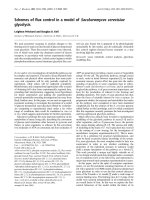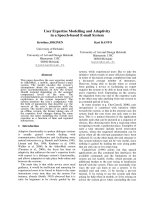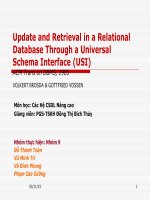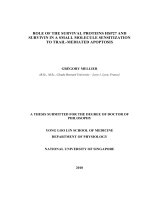Biofilm formation and control in a model drinking water distribution system with phosphorus addition
Bạn đang xem bản rút gọn của tài liệu. Xem và tải ngay bản đầy đủ của tài liệu tại đây (1.91 MB, 199 trang )
BIOFILM FORMATION AND CONTROL IN A MODEL
DRINKING WATER DISTRIBUTION SYSTEM WITH
PHOSPHORUS ADDITION
FANG WEI
NATIONAL UNIVERSITY OF SINGAPORE
2010
BIOFILM FORMATION AND CONTROL IN A MODEL
DRINKING WATER DISTRIBUTION SYSTEM WITH
PHOSPHORUS ADDITION
FANG WEI
(B.ENG)
A THESIS SUBMITTED
FOR THE DEGREE OF PHILOSOPHIAE DOCTOR
DEPARTMENT OF CIVIL ENGINEERING
NATIONAL UNIVERSITY OF SINGAPORE
2010
ACKNOWLEDGEMENT
I would like to express my gratitude and sincere appreciation to my
supervisors, Associate Professor Hu Jiangyong and Professor Ong Say Leong
for their outstanding guidance, invaluable encouragement, consistent
understanding, caring and patience throughout my Ph.D. study.
Many thanks go to all technicians, staff and students, especially Mr. S.G.
Chandrasegaran, Ms. Lee Leng Leng, Ms. Tan Xiaolan at the Environmental
Engineering Laboratory of Division of Environmental Science and Engineering,
National University of Singapore, for their assistance and cooperation in the many
ways that made this research study possible.
My deepest gratitude is also expressed to all my family members, especially
my wife Shi Rui, who gave me endless love and support; and my parents, who
gave me invaluable life and edification.
i
TABLE OF CONTENTS
Pages
ACKNOWLEDGEMENT ................................................................................. i
TABLE OF CONTENTS .................................................................................. ii
SUMMARY .................................................................................................... vii
NOMENCLATURE ........................................................................................ xi
LIST OF FIGURES ........................................................................................ xii
LIST OF TABLES ...........................................................................................xv
LIST OF PLATES ......................................................................................... xvi
CHAPTER ONE INTRODUCTION .................................................................1
1.1 Background ...........................................................................................1
1.2 Objective and Scope of Study ...............................................................5
1.3 Outline of Thesis ...................................................................................7
CHAPTER TWO LITERATURE REVIEW .....................................................8
2.1 Overview of Biofilm Community .........................................................8
2.1.1 Biofilm Formation ......................................................................8
2.1.2 Biofilm Compositions ...............................................................12
2.1.3 Exopolysaccharides (EPS) and Biofilm Structure ....................14
2.2 Biofilm Formation in Drinking Water Distribution System (DWDS) 19
2.2.1 Development of Biofilm in DWDS ..........................................20
2.2.2 Biofilm-related Problems in DWDS .........................................22
2.3 Biofilm Control in DWDS ..................................................................23
ii
2.3.1 Mechanisms of Disinfection .....................................................25
2.3.2 Free Chlorine and Monochloramine Disinfections ...................27
2.3.3 Efficacies of Free Chlorine and Monochloramine Disinfections
............................................................................................................28
2.3.4 Disinfection Resistance of Biofilm Cells ..................................31
2.4 Effects of Nutrient Condition on Biofilm Formation in DWDS.........33
2.4.1 Carbon-limiting and Phosphorus-limiting DWDS....................34
2.4.2 Use of Orthophosphate as Corrosion Inhibitor .........................37
2.4.3 Potential Biological Effects of Addition of Phosphorus in
DWDS ................................................................................................38
2.5 Current Status and Research Needs ....................................................43
CHAPTER THREE MATERIALS AND METHODS....................................49
3.1 Introduction .........................................................................................49
3.2 Experimental Setup .............................................................................50
3.2.1 Annular Reactor System ...........................................................50
3.2.2 Feed Water ................................................................................52
3.2.3 Nutrient Stock ...........................................................................53
3.2.4 Free Chlorine Disinfection ........................................................53
3.2.5 Monochloramine Disinfection ..................................................53
3.3 Sampling and Analysis........................................................................54
3.3.1 Sampling Method ......................................................................54
3.3.1.1 Water Sample ..................................................................54
iii
3.3.1.2 Biofilm Sample ...............................................................55
3.3.2 Water Sample Analysis .............................................................56
3.3.2.1 Heterotrophic Plate Count (HPC) ...................................56
3.3.2.2 Free Chlorine ..................................................................57
3.3.2.3 Monochloramine .............................................................57
3.3.2.4 pH and Temperature ........................................................57
3.3.2.5 Assimilable Organic Carbon (AOC) ...............................57
3.3.2.6 Ion ...................................................................................58
3.3.3 Biofilm Sample Analysis ..........................................................59
3.3.3.1 HPC .................................................................................59
3.3.3.2 Total Carbohydrate Content (TCC).................................59
3.3.3.3 Confocal Laser Scanning Microscopy (CLSM) .............60
3.3.3.4 GN2 Microplate Community Level Assay .....................62
3.3.3.5 Fluorescence in Situ Hybridization (FISH) ....................66
3.3.3.6 Terminal Restriction Fragment Length Polymorphism
(TRFLP) ......................................................................................68
3.3.4 Statistical Analysis ....................................................................73
CHAPTER FOUR RESULTS AND DISCUSSIONS .....................................74
4.1 Introduction .........................................................................................74
4.2 Effects of Phosphorus Addition on Microbial Growth .......................74
4.2.1 Biofilm and Planktonic Cell Growth ........................................74
4.2.2 Biofilm EPS Quantity ...............................................................80
iv
4.2.3 Biofilm Morphology and Structure ...........................................84
4.3 Effects of Phosphorus Addition on Disinfection Efficacy ..................90
4.3.1 Biofilm Development before Disinfections ..............................90
4.3.2 Effects of Disinfection on Biofilm Cell Number ......................90
4.3.3 Effects of Disinfection on Biofilm EPS Quantity .....................96
4.3.4 Effects of Disinfection on Biofilm Morphology and Structure
..........................................................................................................101
4.3.5 Effects of Disinfection on Planktonic Growth ........................ 113
4.4 Effects of Phosphorus Addition on Biofilm Metabolic Potential ..... 116
4.4.1 Substrate Utilization Pattern (SUP) ........................................ 116
4.4.1.1 Phosphorus Addition ..................................................... 116
4.4.1.2 Free Chlorine Disinfection ............................................ 119
4.4.1.3 Monochloramine Disinfection ......................................123
4.4.2 Substrate Utilization Diversity................................................126
4.4.3 Metabolic Potential .................................................................128
4.4.4 Similarity of Metabolic Activity .............................................129
4.5 Effects of Phosphorus Addition on Biofilm Community Structure ..131
4.5.1 FISH ........................................................................................131
4.5.2 TRFLP .....................................................................................136
4.5.2.1 TRLFP Profiles .............................................................136
4.5.2.2 Phylogenetic Assignments ............................................143
CHAPTER FIVE CONCLUSIONS AND RECOMMENDATIONS ...........147
v
5.1 Conclusions .......................................................................................147
5.2 Recommendations .............................................................................149
REFFERENCES ............................................................................................151
PUBLICATIONS ...........................................................................................180
vi
SUMMARY
Microbial regrowth is an important issue in drinking water distribution system
(DWDS) management. Biofilm formation on the internal surface of pipeline
becomes a great concern as the majority of the microbial growth in DWDS is
associated with biofilm development and biofilms are much more disinfectant
resistant than their planktonic counterparts. Biofilm formation in DWDS can
be affected by various factors such as availability of nutrients, presence of
disinfectants, pipeline materials, temperature and water flow rate, etc.
Phosphorus has been recently identified as another limiting nutrient other than
organic carbon to microbial growth in DWDS.
As a commonly used
corrosion inhibitor, phosphate is frequently introduced into DWDS and causes
the increase of phosphorus concentration. Phosphorus addition to DWDS has
potential to increase the microbial growth and change the community structure.
However, the effects of phosphorus on biofilm formation in DWDS are still
not well understood. The purpose of this study is to provide an in-depth
understanding of the biofilm formation and control in DWDS when
phosphorus addition is implemented.
Annular reactors were used to simulate DWDS. Phosphorus addition (3 µg l-1,
30 µg l-1 and 300 µg l-1 of phosphorus) was found to have a complicated effect
on biofilm formation (especially for 30 µg l-1 and 300 µg l-1 of phosphorus
vii
additions). Phosphorus addition can promote the biofilm cell growth (cell
count increased by about 1 log with addition of 30 µg l-1 and 300 µg l-1 of
phosphorus.). However, the addition of 30 µg l-1 and 300 µg l-1 of phosphorus
caused decrease in exopolysaccharides (EPS) quantity by 81% and 77%,
respectively. The results of biofilm structure analysis showed that the addition
of 30 µg l-1 and 300 µg l-1 of phosphorus induced thicker and less
homogeneous biofilms with more biomass. The addition of 3 µg l-1 of
phosphorus, on the other hand, was found to have minor effects on the above
parameters examined. The results in this study confirmed that the addition of
phosphorus to DWDS has a potential to increase the bacterial cell number and
deteriorate the drinking water quality.
In the biofilm control study, free chlorine and monochloramine were used as
disinfectants. The disinfection efficacies of both free chlorine and
monochloramine were increased when phosphorus was added into the reactor
systems. At the same disinfectant dosages, monochloramine showed greater
biofilm removal efficiency than free chlorine (0.86 and 1.32 log cell number
reduction for 0.5 mg l-1 and 2 mg l-1 free chlorine disinfections and 2.13 and
2.96 log cell number reduction for 0.5 mg l-1 and 2 mg l-1 monochloramine
disinfections). Except the control conditions with free chlorine disinfection,
EPS quantities were generally increased when disinfectants were applied (13
and 22 times increases for phosphorus treatment condition with 0.5 mg l-1 and
viii
2 mg l-1 free chlorine disinfections; 7 and 182 times increases for control
condition with 0.5 mg l-1 and 2 mg l-1 monochloramine disinfections; and 144
and 720 times increases for phosphorus treatment condition with 0.5 mg l-1
and 2 mg l-1 monochloramine disinfections). The biofilm structure was also
found to change upon the addition of disinfectant. For example, biofilms
tended to form lager cell colonies with EPS protection in which the denser
biofilm communities may be able to generate a greater diffusion barrier to
protect the cells from the disinfectants penetration. The results from the
disinfection study showed that monochloramine should be a better choice for
biofilm disinfection in DWDS.
The metabolic activity of biofilm cells was examined using substrate
utilization pattern (SUP) based on Biolog GN2 microplate. Substrate
utilization diversity and metabolic potential were calculated based on SUP.
Cluster analysis was used to determine the similarity among different samples.
The species of utilized carbon source changed with phosphorus addition.
Phosphorus addition was also found to increase substrate utilization diversity
(1.25 for control condition and 2.82 for phosphorus treatment condition) and
metabolic potential (1.76 for control condition and 38.95 for phosphorus
treatment condition). Only free chlorine disinfections at 2 mg l-1 caused
obvious decreases in substrate utilization diversity and metabolic potential.
Both phosphorus addition and disinfection could have effects on the biofilm
ix
cell’s physiology or the biofilm community structure but phosphorus addition
played a more important role. The similarity was found to decrease with
phosphorus and disinfectant treatments which suggested that a different
biofilm community structure could be formed with the changes of the external
environmental condition. As a high metabolic rate may induce overproduction
of bacteria in DWDS once carbon level increases, cares should be taken when
phosphorus-based corrosion inhibitor is used in DWDS.
In the biofilm community structure study, both fluorescence in situ
hybridization (FISH) and terminal restriction fragment length polymorphism
(TRFLP) revealed an increase in γ – Proteobacteria with addition of
phosphorus (increased from 0.9% to 5.2% and 2.4% to 7.2% for 30 µg l-1 and
300 µg l-1 of phosphorus treatments, respectively). α – and γ – Proteobacteria
were found to increase with disinfection treatments which indicated pathogens
from γ- Proteobacteria may have a potential to survive and persist from free
chlorine or monochloramine disinfections. The biofilm community diversity
decreased with phosphorus addition and disinfection treatments. As γ –
Proteobacteria contains frank or opportunistic pathogens, such as Salmonella
spp., Escherichia spp., and Legionnella spp., the addition of phosphorus has a
potential to deteriorate drinking water quality. Cares should be taken when
phosphorus based corrosion inhibitors are applied to avoid the potential
outbreak of waterborne diseases.
x
NOMENCLATURE
AOC
Assimilable Organic Carbon
BDOC
Biodegradable Dissolved Organic Carbon
CLSM
Confocal Laser Scanning Microscopy
DOC
Dissolved Organic Carbon
DWDS
Drinking Water Distribution System
EPS
Exopolysaccharides
FISH
Fluorescence in situ Hybridization
HPC
Heterotrophic Plate Count
HRT
Hydraulic Retention Time
MPI
Metabolic Potential Index
PCR
Polymerase Chain Reaction
R2A
Reasoner’s 2 Agar
SUP
Substrate Utilization Pattern
THMs
Trihalomethanes
TOC
Total Carbohydrate Content
TRFLP
Terminal Restriction Fragment Length Polymorphism
xi
LIST OF FIGURES
Pages
Figure 1.1 Structure of the study........................................................................6
Figure 2.1 Biofilm formation process ................................................................9
Figure 2.2 CLSM images of biofilms ..............................................................40
Figure 3.1 Schematic diagram of the annular reactor system ..........................51
Figure 3.2 Standard curve for TCC..................................................................60
Figure 4.1 Effects of phosphorus addition on biofilm formation ....................76
Figure 4.2 Effects of phosphorus addition on planktonic cell count ...............78
Figure 4.3 Effects of phosphorus addition on biofilm EPS quantity ...............82
Figure 4.4 Effects of phosphorus addition on biofilm biovolume ...................87
Figure 4.5 Effects of phosphorus addition on average run length ...................89
Figure 4.6 Effects of phosphorus addition on biofilm homogeneity ...............89
Figure 4.7 Effects of phosphorus on biofilm cell number with free chlorine
disinfection.......................................................................................................93
Figure
4.8
Effects
of
phosphorus
on
biofilm
cell
number
with
monochloramine disinfection...........................................................................94
Figure 4.9 Effects of phosphorus on biofilm EPS quantity with free chlorine
disinfection.......................................................................................................98
Figure 4.10 Effects of phosphorus on biofilm EPS quantity with
monochloramine disinfection.........................................................................100
Figure 4.11 CLSM images for 21st day biofilm in control reactor ................102
xii
Figure 4.12 CLSM images for 21st day biofilm in phosphorus treatment reactor
........................................................................................................................103
Figure 4.13 CLSM images for 39th day biofilm in control reactor with 0.5 mg
l-1 free chlorine ...............................................................................................104
Figure 4.14 CLSM images for 39th day biofilm in phosphorus treatment
reactor with 0.5 mg l-1 free chlorine...............................................................105
Figure 4.15 CLSM images for 39th day biofilm in control reactor with 2 mg l-1
free chlorine ...................................................................................................106
Figure 4.16 CLSM images for 39th day biofilm in phosphorus treatment
reactor with 2 mg l-1 free chlorine..................................................................107
Figure 4.17 CLSM images for 39th day biofilm in control reactor with 0.5 mg
l-1 monochloramine ........................................................................................109
Figure 4.18 CLSM images for 39th day biofilm in phosphorus treatment
reactor with 0.5 mg l-1 monochloramine ........................................................110
Figure 4.19 CLSM images for 39th day biofilm in control reactor with 2 mg l-1
monochloramine ............................................................................................111
Figure 4.20 CLSM images for 39th day biofilm in phosphorus treatment
reactor with 2 mg l-1 monochloramine ...........................................................112
Figure 4.21 Efficacies of disinfection on planktonic cell growth ..................115
Figure 4.22 Effects of phosphorus addition on SUP .....................................119
Figure 4.23 Effects of phosphorus addition on SUP with 0.5 mg l-1 free
chlorine treatment ..........................................................................................122
xiii
Figure 4.24 Effects of phosphorus addition on SUP with 2 mg l-1 free chlorine
treatment ........................................................................................................123
Figure 4.25 Effects of phosphorus addition on SUP with 0.5 mg l-1
monochloramine treatment ............................................................................125
Figure 4.26 Effects of phosphorus addition on SUP with 2 mg l-1
monochloramine treatment ............................................................................126
Figure 4.27 Effects of phosphorus addition on substrate utilization diversity
........................................................................................................................127
Figure 4.28 Effects of phosphorus addition on metabolic potential ..............129
Figure 4.29 Cluster analysis of similarity based on SUP...............................130
Figure 4.30 Effects of phosphorus treatments on biofilm community structure
via FISH .........................................................................................................133
Figure 4.31 Effects of phosphorus addition on TRFLP .................................138
Figure 4.32 Effects of phosphorus addition on TRFLP profiles with 0.5 mg l-1
free chlorine treatment ...................................................................................139
Figure 4.33 Effects of phosphorus addition on TRFLP profiles with 2 mg l-1
free chlorine treatment ...................................................................................140
Figure 4.34 Effects of phosphorus addition on TRFLP profiles with 0.5 mg l-1
monochloramine treatment ............................................................................141
Figure 4.35 Effects of phosphorus addition on TRFLP profiles with 2 mg l-1
monochloramine treatment ............................................................................142
Figure 4.36 Cluster analysis of similarity based on TRFLP ..........................145
xiv
LIST OF TABLES
Pages
Table 2.1 Range of composition of biofilm matrices ......................................13
Table 3.1 Characteristics of feed water to annular reactors .............................52
Table 3.2 Groups of carbon sources in GN2 microplate .................................65
Table 3.3 PCR mastermix ................................................................................70
Table 3.4 PCR protocol....................................................................................70
Table 4.1 TRFLP peak number......................................................................142
Table 4.2 Phylogenetic assignments ..............................................................143
xv
LIST OF PLATES
Pages
Plate 3.1 Actual laboratory set-up of annular reactor system ..........................52
Plate 3.2 Dionex ion chromatography (IC) DX 500 system ............................59
Plate 3.3 Confocal Laser Scanning Microscope System .................................61
Plate 3.4 Carbon sources in GN2 Microplate ..................................................64
Plate 3.5 Microplate reader ..............................................................................66
Plate 3.6 Epifluorescence microscope .............................................................68
Plate 3.7 Bio-Rad iCycler PCR machine .........................................................71
Plate 3.8 CEQ 8000 automated sequencer .......................................................73
xvi
Chapter One-Introduction
CHAPTER ONE
INTRODUCTION
1.1 Background
In a modern drinking water distribution system (DWDS), 99 percent of
bacteria are likely to be in biofilms attached on the internal surfaces. Biofilm
formation serves as a source of planktonic bacteria, some of which can cause
infection and diseases, and sometimes accelerate the corrosion of metal
pipelines. As biofilm formation is unfavorable in DWDS, various strategies
have been utilized to control it. Among these strategies, chlorine and
monochloramine treatments are most widely used because they are efficient,
economical and convenient to apply. Besides adding chemicals, proper
management of the external environmental conditions is also widely used to
control biofilm formation in DWDS.
The external environmental conditions that affect biofilm formation in DWDS
include nutrient level, pipe material, water temperature and flow velocity.
Flow velocity can affect the biofilm structure and is normally determined
during the design of the whole DWDS. Water temperature is a regional and
seasonal parameter which can affect the biofilm density. Although temperature
is not a design parameter, it should be considered for the disinfectant dosage
1
Chapter One-Introduction
requirement if big variations of temperature exist due to the seasonal change.
Another important factor is pipe material which can affect the attachment,
density and community of biofilms in DWDS. The choice of pipe material
depends on its availability and other technical reasons, for example, ground
characteristics, pipe diameter and local water pressure. The above mentioned
external environmental conditions are not supposed to change once the
operation of DWDS starts. Besides these conditions, nutrient level is the most
important factor for the biofilm formation in DWDS and it is adjustable during
the operation of DWDS.
Nutrients such as carbon, nitrogen and phosphorus are essential to the
microbial growth. Conventionally organic carbon is thought to be the only
limiting nutrient in DWDS. In DWDS, organic carbon is normally
characterized as assimilable organic carbon (AOC). AOC level is
recommended to be less than 100 µg l-1 to maintain the bio-stability of
chlorinated drinking water (LeChevallier et al., 1992). Van der Kooij (1990)
suggested a reduction of AOC level to less than 10 µg l-1 when there is no
chlorine residual. However, this low level is really difficult to achieve by the
conventional treatment and it seems impossible to control AOC level at 10 µg
l-1 in practice. In any case, organic carbon is always the compound to
minimize to control biofilm formation in DWDS. Recently, phosphorus has
been found to be another limiting nutrient to the microbial growth in DWDS
2
Chapter One-Introduction
(Sathasivan and Ohgaki, 1999; Lehtola et al., 2002). However, regarding the
effect of phosphorus on the biofilm formation, so far little research has been
done and a controversy still exists. Dosages from one µg l-1 to 400 µg l-1 of
phosphorus have been found to increase microbial growth in water and
biofilms in DWDS (Lehtola et al., 2002; Chu et al., 2005; Hozalski et al.,
2005). However, little attention has been paid to the effects of phosphorus on
other important aspects of biofilms such as EPS production, matrix structure,
metabolic activities and community structure.
The production of EPS is essential for biofilm formation as EPS serves as the
main “cement” for cells and cell products bind water, trap nutrients and protect
cells (Shutherland, 2001). If EPS production could be affected by phosphorus
addition, the biofilm matrix stability and disinfection resistance could also be
affected. One of the ways by which microbial communities adjust to
environmental changes is by changing the structural organization of the
biofilm (Dalton et al., 1994; Woolfaardt et al., 1994; Van Loosderecht et al.,
1995; Moller et al., 1997; Nielsen et al., 2000). So the biofilm structural
information is essential for understanding the effects of environmental
changes on biofilm.
Metabolic potential of biofilm cells can indicate how bacteria adapt to the
environment and also how the environmental changes affect the biofilm
3
Chapter One-Introduction
(Wünsche et al., 1995; Park et al., 2006). Biofilms with high metabolic
potential may induce unstable drinking water quality as sudden fluctuation of
nutrient levels may cause the over growth of biofilms.
A clinical study done by Crespi and Ferra (1997) reported an outbreak of
legionellosis in a hotel in Lanzarote, Spain in 1993, which occurred in a way
concomitant with an anticorrosion treatment of the water system with very
high doses of phosphorus – based corrosion inhibitor. This is the first evidence
that the addition of phosphorus into DWDS could change the microbial
community structure. Batte et al. (2003b) found that phosphorus treatment
increased the proportion of γ – Proteobacteria. As γ – Proteobacteria contains
frank or opportunistic pathogens, such as Salmonella spp., Escherichia spp.,
and Legionnella spp., the addition of phosphorus has a potential to deteriorate
drinking water microbial quality. So it is necessary to examine the effects of
phosphorus addition on the biofilm community, especially with the
disinfection treatment.
In view of the above-mentioned, although the microbial effects of phosphorus
addition in DWDS have been recognized, a number of issues regarding
biofilms in DWDS are still unclear. As biofilms are such a complicated
microbial form compared with their planktonic counterparts, more research
needs to be done to broaden our knowledge on the effects of phosphorus on
4
Chapter One-Introduction
the biofilm in DWDS so as to achieve better drinking water quality control.
1.2 Objective and Scope of Study
The main objective of this study is to investigate the effects of phosphorus on
the biofilm formation and control in DWDS (Figure 1.1). The specific
objectives are listed as follow:
I.
To study the effects of phosphorus addition on biofilm cell growth,
biofilm EPS production, biofilm morphology and structure.
II. To study the effects of phosphorus addition on biofilm control with free
chlorine and monochloramine.
III. To study the effects of phosphorus addition on biofilm cell metabolic
activity.
IV. To study the effects of phosphorus addition on biofilm community
structure.
5
Chapter One-Introduction
Effects of
phosphorus addition
Biofilm growth
Biofilm
quantity
Disinfections
Metabolic
activity
Free chlorine
disinfection
Substrate
utilization
diversity
EPS
production
Morphology
and structure
Monochloramine
disinfection
Metabolic
potential
Community
structure
Fluorescence
in situ
hybridization
Terminal
Restriction
Fragment
Length
In-depth understanding of the effects of phosphorus
addition on biofilm formation and control in DWDS
Figure 1.1 Structure of the study
The assumption that balanced bacterial growth requires substrates with carbon,
nitrogen and phosphorus in an atomic ratio of 106 : 12 : 1 (Goldman et al.,
1987) will be adopted in this study. Once phosphorus is added into DWDS,
the nutrient balance to biofilm cells could be broken and biofilm activity could
be affected. Annular reactor systems will be used to simulate DWDS
throughout this study. In the growth study, cell number and EPS will be
estimated by heterotrophic plate count (HPC) and total carbohydrate content
(TCC), respectively. Confocal laser scanning microscopy (CLSM) will be
utilized to examine the morphology and structure of biofilms. Confocal
6
Chapter One-Introduction
microscope is chosen as it can reveal the three dimensional structures and
present the information at different depths in the biofilm. The metabolic
activity of biofilm cells will be studied by SUP using GN2 microplates. The
biofilm community structure will be investigated by FISH and TRFLP, which
are widely used to study the microbial population in water and wastewater
treatment processes. With the application of these techniques, an in-depth
understanding could be achieved on the effects of phosphorus addition on
biofilm formation and control in DWDS.
1.3 Outline of Thesis
This thesis presents the study on the effects of phosphorus addition on biofilm
formation and control in DWDS. The background information and literature
review, which shows the necessity and importance of the study, are presented
in Chapters One and Two, respectively. The set-up of the annular reactor
system and the operation and sampling methods are presented in Chapter
Three. Chapter Four discusses the experimental results, which includes a
preliminary study to examine the effects of phosphorus addition on biofilm
cell growth. The effects of phosphorus addition on other important aspects of
biofilm community are discussed subsequently in biofilm disinfection, biofilm
cell metabolic activity and biofilm community structure sections. Conclusions
from this study and recommendations for improvements and future study
directions are presented in Chapter Five.
7









